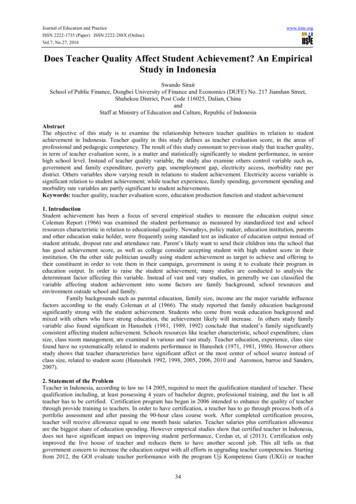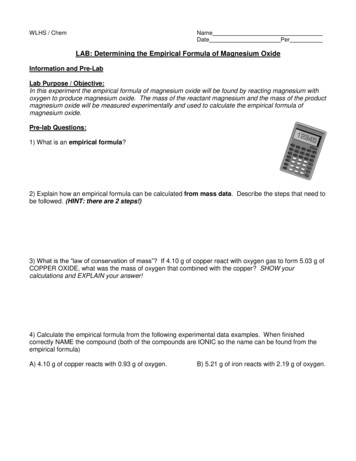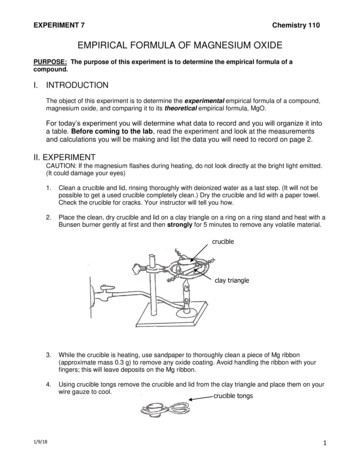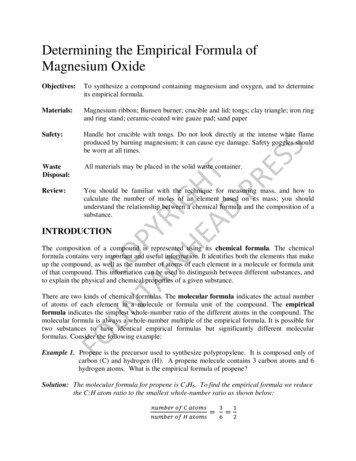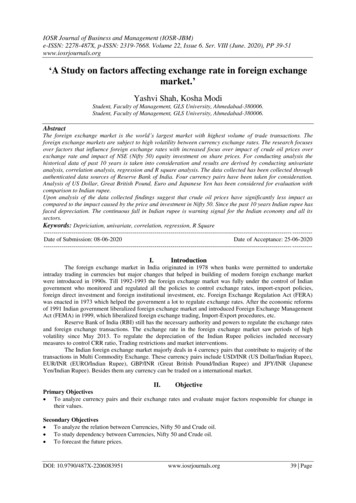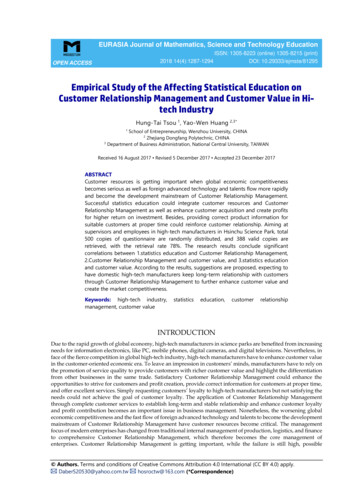
Transcription
EURASIA Journal of Mathematics, Science and Technology Education2018 14(4):1287-1294OPEN ACCESSISSN: 1305-8223 (online) 1305-8215 (print)DOI: 10.29333/ejmste/81295Empirical Study of the Affecting Statistical Education onCustomer Relationship Management and Customer Value in Hitech IndustryHung-Tai Tsou 1, Yao-Wen Huang 2,3*School of Entrepreneurship, Wenzhou University, CHINA2Zhejiang Dongfang Polytechnic, CHINA3Department of Business Administration, National Central University, TAIWAN1Received 16 August 2017 Revised 5 December 2017 Accepted 23 December 2017ABSTRACTCustomer resources is getting important when global economic competitivenessbecomes serious as well as foreign advanced technology and talents flow more rapidlyand become the development mainstream of Customer Relationship Management.Successful statistics education could integrate customer resources and CustomerRelationship Management as well as enhance customer acquisition and create profitsfor higher return on investment. Besides, providing correct product information forsuitable customers at proper time could reinforce customer relationship. Aiming atsupervisors and employees in high-tech manufacturers in Hsinchu Science Park, total500 copies of questionnaire are randomly distributed, and 388 valid copies areretrieved, with the retrieval rate 78%. The research results conclude significantcorrelations between 1.statistics education and Customer Relationship Management,2.Customer Relationship Management and customer value, and 3.statistics educationand customer value. According to the results, suggestions are proposed, expecting tohave domestic high-tech manufacturers keep long-term relationship with customersthrough Customer Relationship Management to further enhance customer value andcreate the market competitiveness.Keywords: high-tech industry,management, customer DUCTIONDue to the rapid growth of global economy, high-tech manufacturers in science parks are benefited from increasingneeds for information electronics, like PC, mobile phones, digital cameras, and digital televisions. Nevertheless, inface of the fierce competition in global high-tech industry, high-tech manufacturers have to enhance customer valuein the customer-oriented economic era. To leave an impression in customers’ minds, manufacturers have to rely onthe promotion of service quality to provide customers with richer customer value and highlight the differentiationfrom other businesses in the same trade. Satisfactory Customer Relationship Management could enhance theopportunities to strive for customers and profit creation, provide correct information for customers at proper time,and offer excellent services. Simply requesting customers’ loyalty to high-tech manufacturers but not satisfying theneeds could not achieve the goal of customer loyalty. The application of Customer Relationship Managementthrough complete customer services to establish long-term and stable relationship and enhance customer loyaltyand profit contribution becomes an important issue in business management. Nonetheless, the worsening globaleconomic competitiveness and the fast flow of foreign advanced technology and talents to become the developmentmainstream of Customer Relationship Management have customer resources become critical. The managementfocus of modern enterprises has changed from traditional internal management of production, logistics, and financeto comprehensive Customer Relationship Management, which therefore becomes the core management ofenterprises. Customer Relationship Management is getting important, while the failure is still high, possible Authors. Terms and conditions of Creative Commons Attribution 4.0 International (CC BY 4.0) apply.Daber520530@yahoo.com.twhosroctw@163.com (*Correspondence)
Tsou et al. / Statistical Education on Customer Relationship ManagementContribution of this paper to the literature The function of statistics education could benefit high-tech manufacturers practicing Customer RelationshipManagement, ensure the service quality and cooperation model being more mature.Aiming at customers in different industries and with distinct customer characteristics, high-techmanufacturers should adopt differential Customer Relationship Management strategies meeting withcustomer needs.To match the design of interaction courses, a training team must be capable of guiding learners’ capabilitiesof learning and participating in interaction so that the employees are willing to use statistical tools andcommunicate with instructors or peers. because enterprises invest in excessive initial costs, solution-providing manufacturers show inadequateinformation statistics capability, and internal talents of enterprises are lack of professional capabilities to result inunobvious effectiveness. Successful Customer Relationship Management allow designing marketing activityaiming at individual customer needs and enhancing the opportunities of customer acquisition and profit creationto acquire higher return on investment as well as provide correct product information for suitable customers atproper time. In this case, applying statistics education to Customer Relationship Management could enhance theprofessional capabilities of internal talents of high-tech manufacturers and specify and accurate the evaluationindicators for Customer Relationship Management. However, research on Customer Relationship Management inhigh-tech industry is rare. It is therefore a primary issue for high-tech manufacturers reinforcing CustomerRelationship Management through statistics education to keep long-term relationship with customers, promotecustomer value, and create the market competitiveness.LITERATURE REVIEWStatistics EducationGuo and Chan-Olmsted (2015) contained basic statistical knowledge and basic statistical skills in statisticseducation, such as being able to organize and classify data, make statistical tables with classified data, calculatemeans and modes, draw bar charts or broken line graphs with statistical data, read statistical charts, and be awareof longer figure in a bar chart standing for more or larger value. Statistics education aims to systematically organizeand analyze data to understand the phenomenon (Miranda, Chamorro, Rubio, & Morgado, 2013; Becerril-Ángel,Castillo-Pérez, Montiel-Jarquín, Villatoro-Martínez & García-Cano, 2017). Čeněk, Smolík, and Svatošová (2016)indicated that statistics education included understanding means and modes being the representatives ofpopulation and the abstract meaning of statistical terms, realizing the phenomenon with the information instatistical charts or statistical figures, extracting meaningful information from statistical charts for analyses,explanation, and criticism, understanding the changes surrounding the life by explaining statistical charts, andproceeding reasonable prediction of uncertain situations (Shokohyar, Tavallaee, & Karamatnia, 2016). Durkin,McGowan, and Murray (2014) proposed four directions of (1) collecting data, (2) sorting data, (3) presenting data,and (4) explaining data to explain the points in the statistics teaching process. A complete statistics teachingtherefore should cover dynamic activities allowing students’ participation to develop necessary insight or enhancethe level of understanding from collecting relevant data. Hu, Chiu, Hsu, and Chang (2015) proposed four steps ofstatistics teaching, namely (1) questioning, (2) collecting data, (3) analyzing data, and (4) forming andcommunicating the results. The points were to clarify the myth of statistics teaching, stress on the importance ofstatistical ideas, and explain the mutual correlation in the statistical process through the statistical process structurediagram.Referring to He, Zha, and Li (2013), three dimensions are applied to statistics education in this study.(1) Process teaching: Complete teaching activities should start from forming questions and transform intostatistical questions. Aiming at questions, data are then collected (including deciding the sample size andthe way of sampling). Representative data are then established, classified, and presented with figures ortables for analyses. Finally, the data contents are described and explained, i.e. interpreting the implicationsin figures and tables.(2) Basic idea: They are the ideas learned according to designed materials, covering sorting data, presentingdata, explaining data, making and reading, and interpreting statistical charts, which are the stage knowledgein the statistical process.(3) Analysis capability: It refers to decide how to sort data, present data, and explain data, according to data, tofurther understand the phenomenon according to the organized results, extract meaningful information foranalyses, explanation, and criticism, and reasonably predict or infer uncertain situations.1288
EURASIA J Math Sci and Tech EdCustomer Relationship ManagementChoudhury and Harrigan (2014) regarded Customer Relationship Management as the tactic of enterprisesunderstanding and influencing customer behaviors through meaningful communication to enhance newcustomers, prevent existing customers from loss, promote customer loyalty, and enhance customers’ profitcontribution. Somera (2014) referred it as all activities changing causal customers into loyal customers by satisfyingor exceeding the needs to generate re-purchase behaviors. Jone, Taylor, and Reynolds (2014) pointed out CustomerRelationship Management as a broad process and information technology to manage potential and existingcustomers and partnership with enterprises through marketing, sales, and services. Aichner and Jacob (2014)defined Customer Relationship Management as continuous relationship marketing, stressing on helpingenterprises seek for and segment valuable customers, provide different products and channels for the satisfaction,and maintain good relationship with customers to further enhance the contribution for enterprises making profits.Moretti and Tuan (2013) referred Customer Relationship Management as to understand customer needs, providebest personalized services, satisfy customer needs, and create favorable value and interactive relationship.Enterprises should emphasize the interaction with customers and the service to constantly enhance customerservice quality with various innovative products and services, manage Customer Relationship Management for thesustained-yield management of enterprises, and build long-term win-win by establishing long-term and closerelationship with customers. Griffiths and McLean (2015) pointed out Customer Relationship Management asbusiness model and strategy application where enterprises actively deepened the relationship with customers tograsp customer information and utilized such customer information to make distinct strategy application in orderto satisfy different customer needs.Referring to Chua and Banerjee (2013), the following dimensions are used for measuring the performance ofCustomer Relationship Management in this study.(1) Customer acquisition: To integrate the detailed data of various independent sources, analyze newcustomers’ purchase behaviors, establish Propensity Model to confirm the products which customers wouldmost possibly purchase, and further understand the possible time when customer contact with the companyand the way of communication.(2) Customer reinforcement: To confirm the customer segmentation with the richest profits, be aware of themost possibly purchased products, and effectively apply cross-selling and up-selling so as to stabilize therelationship with customers and create more profits.(3) Customer contact: To apply the preferred purchase channels of customers, through customers’ PropensityModel, to reduce customer loss and acquire the lifelong value of customers by analyzing the purchasebehavior changes in the life cycle.Customer ValueGuerreiro, Rita, and Trigueiros (2015) pointed out customers’ distinct value, which was composed of highpersonalization and heterogeneity. Dootson, Beatson, and Drennan (2016) referred customer delivered value as thedifference between the overall customer value and the overall customer cost; the overall customer value referredto the set of customers expecting to acquire benefits from specific products or services. Ou Yang, Shieh, and Tzeng(2013) defined customer value as consumers’ comprehensive evaluation of product effectiveness according to theperceived acquisition and devotion. Alqahtani and Saba (2013) regarded “relationship” as a precious asset, ratherthan customer themselves, and the relationship with customers to evaluate future cash flow and measure the valueof the relationship (customers’ lifelong value). It meant that enterprise value would eventually be the sum ofcustomer relationship value, and such a sum would be created merely when pursuing, developing, and keepingbeneficial customer relationship. Polláka and Dorčákb (2016) pointed out the direct way to understand customers’perceived value as to ask customers. Nevertheless, different customers showed distinct opinions about value thatacquiring value from the broad perception could not clearly understand the relevance of value. Utilizing valuefocused thinking for the understanding therefore was a better strategy. Hill (2014) regarded the items concernedby customers on the Internet purchase as value and transformed it into goals.Referring to Lee, Shia, and Huh (2016), two dimensions of self-satisfaction and group identification for customervalue are used in this study.(1) Self-satisfaction: including the presentation of entertainment, exploration, and personal value (selfsatisfaction).(2) Group identification: containing the presentation of saving, quality, convenience, and personal value (groupidentification).1289
Tsou et al. / Statistical Education on Customer Relationship ManagementResearch DesignŠtefko, Bačík, and Fedorko (2014) mentioned that Customer Relationship Management could reinforce anorganization through statistics education to acquire, analyze, and apply various data related to customers throughdatabase, statistical tools, data mining, machine learning, business intelligence, and data report and to approachcustomers. Harrigan and Miles (2014) indicated that a company which was running Customer RelationshipManagement should acquire customer data through the information channels (multi-channel marketing). Suchinformation could also be acquired through external resources, such as market surveys and address database.Statistics education could be used for centralizing the storage and management of Customer RelationshipManagement data in order to avoid data chaos caused by various versions. Yazdanparast, Joseph, and Muniz (2016)stated that Customer Relationship Management data should be true, complete, accurate, and sole and presentaccessibility for those who need the data being able to conveniently interview and use such data. It was doubtlessfor the companies which regarded Customer Relationship Management as the strategy. The following hypothesisis therefore proposed in this study.H1: Statistics education present significant correlations with Customer Relationship Management.Parsons (2013) indicated that researchers stressed on the spirit of Customer Relationship Management, amongvarious definitions, as enterprises applying the entire resources, comprehensively understanding each customer,and contacting and interacting with customers through effective channels to enhance customers’ lifelong value. Heet al. (2013) indicated that Customer Relationship Management (CRM) was originated from the idea of relationshipmarketing, where customer value was first realized and customers’ expected value was then transmitted to furtherinfluence customer satisfaction and repurchase behavior. Trainor, Andzulis, Rapp, and Agnihotri (2014) stated thatCustomer Relationship Management, aiming at marketing, customer service, and logistics support, improvedbusiness processes with information technology and integrate multiple channels for customer communication sothat enterprises could choose different communication channels, according to individual customer needs, toenhance customers’ perceived value. Hu et al. (2015) indicated that Customer Relationship Management coulddefine customer groups with distinct value and enterprises could satisfy customer value in different segmentationwith new products and new channels to establish long-term relationship. However, enterprises had to continuouslylisten to customers’ voice, attempt to enhance customers’ value contribution, and inspect the changes of customerneeds so as to match the marketing strategies and even change the organization structure. Accordingly, thefollowing hypothesis is proposed in this study.H2: Customer Relationship Management shows remarkable correlations with customer value.Rodriguez, Peterson, and Ajjan (2015) indicated that the emergence of Customer Relationship Management andthe change in enterprises’ marketing had customization become important in the fierce competition. Hutter, Hautz,Dennhardt, and Füller (2013) argued that customer value analysis was the key preparation for effectively settingup the customized marketing program and reducing the waste of marketing budget. For this reason, statisticseducation should be utilized for enterprises proposing more systematic customer value model to solve the problemin analyzing customer value. Vernuccio (2014) indicated that enterprises could no longer neglect the importance ofcustomer value. A lot of companies therefore started to adopt customer-centered thinking to design products orservices satisfying customer needs. In this case, statistics education allowed enterprises applying scientific methodsto definite analyze customer needs and expectation for enterprises, when making decisions, accurately digging andsatisfying customers’ real value needs. The following hypothesis is further proposed in this study.H3: Statistics education reveals notable correlations with customer value.RESEARCH METHODMethod and ModelSEM statistics software, AMOS, is utilized in this study for screening indicators for the measurement model.The “modification index” (MI) offered in AMOS is used for the process. The larger MI value stands for the higherexpectation χ2 to delete the question; especially, indicators with MI value higher than 3.84 should be deleted. Inresidual analysis, the absolute values of all standardized residuals are smaller than the suggested 2.58, revealinggood fit between the measurement model and samples. Regarding the test of the composite reliability of latentvariables, it is suggested being higher than 0.6. The higher composite reliability of latent variables presents thatsuch observed variables could better measure the latent variables. The composite reliability of latent variables inthis study is higher than 0.6, and not an observed variable with the factor load crossing two dimensions larger than0.5. The measurement model therefore shows satisfactory convergent validity and discriminant validity.1290
EURASIA J Math Sci and Tech EdTable 1. Model analysis resultevaluation indicatorp -valueχ2/d.f.GFIAGFIOverall model fitCFIRMRRMSEANFIIFIjudgment standardp -value 0.05 3 0.9 0.9 0.9 0.05, better lower than 0.0250.05 0.08 GoodBetter lower than 0.05 0.9 0.9Table 2. SMC of variables and dimensionsStatistics EducationCustomer Relationship asic idea α2reinforcementteaching α1capability α3 acquisition β1contact 30.9140.9690.0160.0220.9540.928Customer 0.90Research Sample and ObjectAiming at high-tech industry, supervisors and employees of high-tech manufacturers in Hsinchu Science Parkare randomly sampled for 500 copies of questionnaire. Total 388 valid copies are retrieved, with the retrieval rate78%. Hsinchu Science Park is the first science park in Taiwan and is the major technology town for highlydeveloping high-tech OEM that it is named “Taiwan Silicon Valley”. Manufacturers in the park concentrate onElectronic Manufacturing Services. There are more than 400 high-tech OEM and service manufacturers, with theindustries covering semiconductors, computers, telecommunications, opto-electronics, refined mechanics, andbiotechnology. It is one of the places with densest semiconductor manufacturers globally and is a primary town forsemiconductor manufacturing in the world. A lot of economic and work opportunities are created in HsinchuScience Park, e.g. famous companies, like TSMC, establishing offices there.Reliability and Validity TestValidity refers to a measuring scale being able to actually measure what a researcher would like to measure.Common validity contains “content validity”, inclined to qualitative concept, “criterion validity”, evaluating withidentified external criteria and the correlation coefficient of this test, and “construct validity”, used for evaluatingthe measurement being consistent with other observable variables. The questionnaire contents in this study arebased on past theories and referred to the actual situations of researched objects to design the measuring tool whichcould truly express the essence of objects and the complete representativeness and to ensure the questionnaireconforming to content validity. Besides, the ultimate common estimate of factor analysis results is applied to testthe construct validity of questions. The acquire validity appears in 0.7 0.9, showing the satisfactory validity testresult of this research questionnaire.EMPIRICAL RESULT ANALYSISTest of Model Fit“Maximum Likelihood” (ML) is used in this study, and the acquired analyses achieve the convergence. Overallspeaking, the indicators of the overall model fit in this study pass the test, Table 1, thoroughly reflecting goodexternal quality of the model.In regard to the test of internal model quality, the SMC of manifest variables is higher than 0.5 (Table 2),revealing good indicators of various latent variables. Furthermore, latent variables of statistics education, CustomerRelationship Management, and customer value show the reliability higher than 0.6, and the average varianceextracted of dimensions is higher than 0.5 (Table 3) that they conform to the test requirement of internal modelquality.1291
Tsou et al. / Statistical Education on Customer Relationship ManagementTable 3. Composite reliability and average variance extracted of variablesItemStatistics EducationCustomer Relationship Managementcomposite reliability0.8430.871average variance extracted0.800.83Customer Value0.8660.82Figure 1. Path relationship diagramTable 4. Hypothesis testResearch hypothesisH1H2H3Correlation Empirical upportedSupportedTest of Path RelationshipWhen latent variables of process teaching, customer acquisition, and self-satisfaction are regarded as thereference indicators fixed 1, the cause-effect relationship path diagram in Figure 1 shows the significant estimateof the relationship between dimensions and variables. Basic idea α2 1.08 presents better explanation than processteaching α1; customer reinforcement β2 1.11 and customer contact β3 1.23 show better explanation than customeracquisition β1, and group identification σ2 appears relatively higher customer value than self-satisfaction σ1. Thehypothesis test results are shown in Table 4.CONCLUSIONFrom the research results, statistics education reveals significantly positive effects on Customer RelationshipManagement. High-tech manufacturers could train the personnel’s statistics education through the interactionbehavior and information with customers to establish the structure and content of customer data, proceedsegmented and differential services for customers, and establish correct customer value to create customer valueand establish good Customer Relationship Management. The operation regulations for Customer RelationshipManagement should be made and the customer database should be established to allow the sales personnel in hightech manufacturers proceeding statistics with customer data and the consumption habits, to enhance thesatisfaction by reinforcing differential services, and to dig out the potential benefits and long-term profits ofcustomers to maximize the effectiveness of Customer Relationship Management and further increase newcustomers and prevent old customers from loss. By keeping up with modern customers’ consumption habits stepby-step and applying and reinforcing the integration of hardware and software, it could provide more convenient1292
EURASIA J Math Sci and Tech Edservices and real-time information for customers as well as comprehensively enhance the service and informationprovision. It is not simply the innovation of service, but Customer Relationship Management should be properlydone to enhance customer value. It is the improvement to which high-tech manufacturers have to make efforts forthe sustained-yield management. What is more, employees’ statistical capability, Customer RelationshipManagement, and customer value concepts could be reinforced through statistics education so that the conceptscould be used in practice, allowing high-tech related services be more comprehensive to present bettercompetitiveness in the competitive market and to enhance the profits.SUGGESTIONBy organizing the important results and findings, following practical suggestions are proposed.1. High-tech manufacturers stress more on the supply chain partnership with precision division that the needsfor Customer Relationship Management should be particularly emphasized. The function of statisticseducation could benefit high-tech manufacturers practicing Customer Relationship Management, ensurethe service quality and cooperation model being more mature, and further enhance customer value and codevelopment with customers.2. The establishment of Customer Relationship Management should inspect and confirm the operationprocedure conforming to customer needs and reinforce the requirement for employee quality, especiallythose directly interacting with customers, e.g. drivers, OP personnel, sale representatives, and customerservice personnel. Constantly reinforcing the professional knowledge and professionalism of first-lineemployees could acquire larger customer trust and loyalty. Aiming at customers in different industries andwith distinct customer characteristics, high-tech manufacturers should adopt differential CustomerRelationship Management strategies meeting with customer needs. Different service and interaction modelswould benefit the maintenance of long-term relationship with customers.3. High-tech manufacturers should also emphasize the training team of statistics education. To match thedesign of interaction courses, a training team must be capable of guiding learners’ capabilities of learningand participating in interaction so that the employees are willing to use statistical tools and communicatewith instructors or peers. Moreover, a training team must spend more time and energy to respond toemployees’ problems so that the employees perceive the concerns and emphasis of the training team,without giving up the learning because of the sense of loneliness.REFERENCESAichner, T., & Jacob, F. (2014). Measuring the degree of corporate social media use. International Journal of MarketResearch, 57(2), 257-275.Alqahtani, F. A., & Saba, T. (2013). Impact of Social Networks on Customer Relation Management (CRM) inProspectus of Business Environment. Journal of American Sciences, 9(7), 480-486.Becerril-Ángel, M. Castillo-Pérez, J. J., Montiel-Jarquín, Á. J., Villatoro-Martínez, A., García- Cano, E. (2017). Aspectsof the submission of articles to scientific journals, European Journal of General Medicine, 14(2), , J., Smolík, J., & Svatošová, V. (2016). Marketing on Social Networks: Content Analysis of Facebook .2016.26.9Choudhury, M. M., & Harrigan, P. (2014). CRM to social CRM: the integration of new technologies into 5254X.2013.876069Chua, A., & Banerjee, S. (2013). Customer knowledge management via social media: the case of Starbucks. Journalof Knowledge Management, 17(2), 237-249. https://doi.org/10.1108/13673271311315196Dootson, P., Beatson, A., & Drennan, J. (2016). Financial institutions using social media – do consumers perceivevalue? International Journal of Bank Marketing, 34(1), 9-36. https://doi.org/10.1108/IJBM-06-2014-0079Durkin, M., McGowan, P., & Murray, L. (2014). Perspectives on the potential for social media to improvecommunication in small business–bank relationships. The International Journal of Entrepreneurship andInnovation, 15(4), 251-264. https://doi.org/10.5367/ijei.2014.0163Griffiths, M., & McLean, R. (2015). Unleashing corporate communications via social media: A UK study of brandmanagement and conversations with customers. Journal of Customer Behaviour, 14(2), 8057891293
Tsou et al. / Statistical Education on Customer Relationship ManagementGuerreiro, J., Rita, P., & Trigueiros, D. (2015). A Text Mining-Based Review of Cause-Related Marketing Literature.Journal of Business Ethics, 139(1), 111-128. https://doi.org/10.1007/s10551-015-2622-4Guo, M., & Chan-Olmsted, S. (2015). Predictors of Social Television Viewing: How Perceived Program, Media, andAudience Characteristics Affect Social Engagement with Television Programming. Journal of Broadcasting &Electronic Media, 59(2), 240-258. gan, P., & Miles, M. (2014). From e-
correlations between 1.statistics education and Customer Relationship Management, 2.Customer Relationship Management and customer value, and 3.statistics education and customer value. According to the results, suggestions are proposed, expecting to have domestic high-tech manufacturers keep long-term relationship with customers through Customer .



